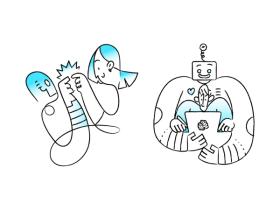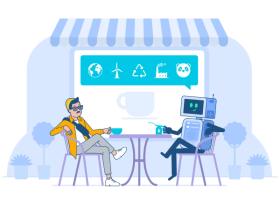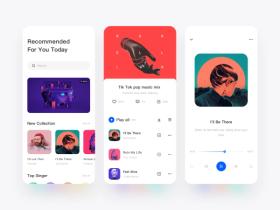Project Discovery: What is it and Why Do You Need it?
Published: November 8, 2023
14 min read
In this article, you'll learn:
1
❓ When Do You Need a Discovery Stage?
2
📈 Benefits of the Project Discovery: How it Will Help You
3
🛠️ Inner Flows of a Project Discovery Stage
4
📆 How Much Time Does a DS Usually Take?
5
💸 How Much Does It Cost to Conduct a Project Discovery?
6
🔋 Stormotion’s Case Study
7
💡 Takeaways
Establishing great communication with the client plays a crucial role in a project’s future, and here the DS helps us to figure out the client’s expectations, project input, and the best ways of realization.
As an experienced development company, we’d like to share our expertise and show the processes that our team & clients are going through at this stage. Let’s take a look at Stormotion’s point of view on conducting a Discovery Phase.
❓ When Do You Need a Discovery Stage?
The Project Discovery process is a common stage in the development lifecycle of many digital products. The most common cases when it’s required are:
However, as we noticed at the beginning of this paragraph, some stages may be replaced or skipped, if reasonable. Thus, the length and cost of the Discovery Phase will change as well.
🛠️ Inner Flows of a Project Discovery Stage
Project Discovery Phase is, in general, a process of avoiding possible misunderstandings and finding a common ground between the customer and the Tech Team. As in several steps from the previous section we mentioned extra research, there are actually two parallel Discovery Stages within the conduction of the whole process. Those are DS on UX and DS on technology.
Let’s figure out what these stages are about and who is responsible for the conduction.
Discovery Stage on UX
Previously we mentioned a UX-designer as one of the key roles in a team structure for a proper DS conduction. Specifically, in this section, he’s the main character that’s responsible for the whole stage.
As we are discussing the inner flows of a global process, the objectives are quite similar. However, we need to specify them a little bit more in terms of UX. So what are the goals for the DS on UX?
- Research UX best practices for the current market.
Depending on the project and its objectives, the UX design may significantly vary in different cases. If a client wants to create a companion app, there are some specified UX best practices that should be considered in the design. Minimizing the irrelevant information, creating the most convenient block positioning, and establishing high-speed performance are the priorities for this case.
- Take into account the comparative advantages of direct competitors.
Comparative advantages as a term suppose that a company offers products or services at a lower opportunity cost than its market competitors. A designer should research the UX features that make competitors look more beneficial for a client when it comes to choosing.
For example, a customer’s idea is to integrate his project into Microsoft Teams. Therefore, our team needs to find out a way to integrate the project’s features, considering the inner Teams’ restrictions. To do so, we conduct a Discovery Phase where we create a Proof of Concept, get our technical answers, and finally provide an estimate.
- Determine a suitable Tech Stack.
Every case is unique, and it’s almost impossible to tell in advance the Tech Stack we should use to match the customer’s needs. We at Stormotion specialize in creating products using our React Native skills. However, in case our clients need something more than React Native may offer, we are confident enough to pick from Java, Kotlin, Node.js, or TypeScript to deliver a quality product.
Exactly after hearing out all the ideas and requirements from the client, it becomes possible for a Tech Lead to select Tech Stack that allows achieving every objective.
📆 How Much Time Does a DS Usually Take?
The main factors that affect the time frames for this stage are:
- project complexity;
- its size (=scope of work);
- and the company’s workload at the moment.
On average for small projects like creating simple Proof of Concepts, it may take about 2 weeks to conduct a thorough DS. For complex projects like creating and connecting a companion app to an IoT device, Discovery Phase may take up to 8 weeks.
💸 How Much Does It Cost to Conduct a Project Discovery?
Since Discovery requires hours of researching, brainstorming, conducting market analysis, and creating wireframes it’s usually considered as any other kind of work that the agency does for you. Therefore, it makes the following rule pretty reasonable:
-
Present all the desired time frames and deadlines for the project as soon as possible. It’s vital both for the team and the quality of the product to have the deadlines set beforehand.
-
Introduce every single stakeholder for the future project. Without a doubt, keeping in mind every stakeholder from the start grants your Team a clear vision for the planning and developing stages.
-
Present references and mood boards that inspired your project vision in any way. Don’t be afraid to express your thoughts and desires via the work of other people. In most cases, showing the reference and explaining what exactly caught your attention will help your team to build the product you exactly desire.
🔋 Stormotion’s Case Study
We’d like to present to you an example of a Discovery Stage, which we conducted for our client, before jumping to software development.
Based in the USA, Norsk develops and sells batteries designated for outdoor activities. We were supposed to develop a companion app with the integration of BLE modules for managing those batteries. For a better understanding, we’ll show you what was the input and the output for the project Discovery Phase.
Input for a Discovery Stage
On the Norsk Guardian project, we were able to identify 6 main points that can be regarded as input for DS. Those were the requirements that needed extra research in order to prove their viability and pick the best tech solution. Let’s take a look at what the customer requests were:
Challenge № 1: “We’d like to monitor up to 3 batteries at once, aggregating information for display in the app. Also, as an average boat has 2-3 batteries that will be charged and discharged simultaneously, the voltage of each battery shouldn't be too different at the moment. We want to monitor any parameter that may “fall out of sync” and have the ability to watch the changes in these parameters over time".
Our Output: We tested the possibility of connecting multiple batteries in parallel and found that we could at least simulate this process for the user. As for the monitored parameters and triggers —- we found them out from the client and consolidated them within one list given to the corresponding developer.
Challenge № 5: “We’d like to have users logging into the app (via Facebook, Google, etc) before being able to save a battery”.
Our Output: We have set up a database, where we have entities like 'user' and 'battery'. After signing up using email or socials listed, the user is offered to add a battery. If a user adds it and confirms ownership within the app, the battery is associated with them.
Сhallenge № 6: “We want to have indicators that show that the battery is actively charging”
Our Output: We found out that we can understand it based on voltage changes, and started working on the corresponding animation.
💡 Takeaways
A successful Discovery Stage creates a strong foundation for further project development. Earlier understanding of precise project requests & limits and market demand makes project management stages easier for a team to handle. At Stormotion, we follow such stages on a project timeline throughout the Discovery Phase:
- Onboarding
- Story Building and Project Charter Creation
- Prototyping
- Technical Research
- Providing a Detailed Estimate
The successful Discovery phase leads to a better level of understanding of business and technical requirements for a software development project. Thus, making this phase of a project crucial for both the discovery team and the customer to conduct beforehand.
Was it helpful?
Read also

Stormotion's ChatGPT Journey

Top 5 Best Practices for Integrating ChatGPT in Your App

How to Build SaaS App Like Spotify
Our clients say
![Stormotion client David Lesser, CEO from [object Object]](/static/93e047dadd367691c604d8ffd1f54b58/b0e74/david.png)
They were a delight to work with. And they delivered the product we wanted. Stormotion fostered an enjoyable work atmosphere and focused on delivering a bug-free solution.
David Lesser, CEO
Numina
